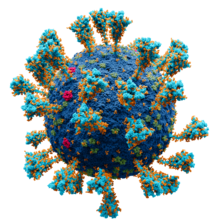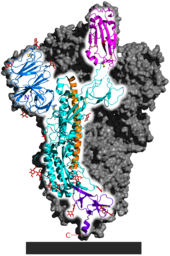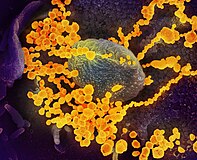ပြင်းထန်အသက်ရှုလမ်းကြောင်းရောဂါ ကိုရိုနာဗိုင်းရပ်စ် ၂
| Severe acute respiratory syndrome coronavirus 2 | |||||||||||
|---|---|---|---|---|---|---|---|---|---|---|---|

| |||||||||||
| Colourised transmission electron micrograph of SARS-CoV-2 virions with visible coronae | |||||||||||

| |||||||||||
Atomic model of the external structure of the SARS-CoV-2 virion. Each "ball" is an atom.[၁]
| |||||||||||
| ဗိုင်းရပ်စ် ခွဲခြားခြင်း | |||||||||||
| (unranked): | ဗိုင်းရပ်စ် | ||||||||||
| Realm: | Riboviria | ||||||||||
| မျိုးပေါင်းစု: | incertae sedis | ||||||||||
| မျိုးစဉ်: | Nidovirales | ||||||||||
| မျိုးရင်း: | Coronaviridae | ||||||||||
| မျိုးစု: | Betacoronavirus | ||||||||||
| Subgenus: | Sarbecovirus | ||||||||||
| မျိုးစိတ်: | |||||||||||
| Virus: | Severe acute respiratory syndrome coronavirus 2
| ||||||||||
| Notable variants | |||||||||||
| Synonyms | |||||||||||
| |||||||||||
ပြင်းထန် အသက်ရှူလမ်းကြောင်းဆိုင်ရာရောဂါလက္ခဏာ ကိုဖြစ်စေသော ကိုရိုနာဗိုင်းရပ်စ် ၂ (SARS-CoV-2)[၂][၃](ယခင်အမည် 2019-nCoV)[၄][၅][၆]သည် positive-sense single-stranded RNA virus အမျိုးအစားဖြစ်သည်။[၇][၈] ကိုရိုနာဗိုင်းရပ်စ် ရောဂါ ၂၀၁၉(COVID-19) ကို ဖြစ်စေသော ဗိုင်းရပ်စ်ပိုးတစ်မျိုးလည်းဖြစ်၏ ။ ၎င်းဗိုင်းရပ်စ်ပိုးသည် လူအချင်းချင်း ကူးစက်တတ်သည်။ ၎င်းသည် ၂၀၁၉-၂၀_ကိုရိုနာဗိုင်းရပ်စ်_ဖြစ်ပွားမှု၏ အကြောင်းတစ်ရပ်လည်းဖြစ်ပေသည်။[၉]
ယခုဗိုင်းရပ်စ်(SARS-CoV-2) သည် လင်းနို့ကိုရိုနာဗိုင်းရပ်စ်နှင့် မျိုးရိုးဗီဇ နီးကပ်စွာတူညီသဖြင့် လင်းနို့သယ်ဆောင်သော ဗိုင်းရပ်စ်မှ ပေါ်ထွက်လာခဲ့သည်ဟု ညွှန်းဆိုပြောကြားကြသည်။ [၁၀][၁၁][၁၂] သင်းခွေချပ်ကဲ့သို့သော ရောဂါသိုမှီးရာကြားတိရစ္ဆာန်က လူသို့စတင်ရောက်ရှိစေသော ပတ်သက်မှုရှိနိုင်သည်ဟုလည်း ထင်မြင်ကြသည်။ [၁၃][၁၄] မျိုးရိုးဗီဇခွဲခြားခြင်းပညာရပ်(taxonomy) ရှုထောင့်မှ SARS-CoV-2 ကို ပြင်းထန် အသက်ရှူလမ်းကြောင်းရောဂါလက္ခဏာနှင့်ဆက်နွယ်သော ကိုရိုနာဗိုင်းရပ်စ်(SARSr-CoV) မျိုးစိတ်မှ တစ်မျိုးဟု ခွဲခြားဖော်ပြကြ၏ ။ [၂]
လူ့ကိုယ်ခန္ဓာပြင်ပတွင် ဗိုင်းရပ်စ်၏ အလွတ်သဘောပုံစံ viron (free form of the virus) ကို ဆပ်ပြာက သေစေနိုင်သည်။ [၁၅]
ဤဗိုင်းရပ်စ်ကို တရုတ်နိုင်ငံ ဟူပေ့ခရိုင် ဝူဟန်မြို့၌ ပထမဆုံးစတင်ခွဲခြားသတ်မှတ်နိုင်ခဲ့၍ "ဝူဟန် ဗိုင်းရပ်စ်" သို့ "ဝူဟန်ကိုရိုနာ ဗိုင်းရပ်စ်" ဟူ၍ ရံခါ၌ ရည်ညွှန်းခဲ့သည်များလည်းရှိသည်။ [၁၆][၁၇][၁၈][၁၉] ကမ္ဘာ့ကျန်းမာရေးအဖွဲ့ (WHO) က နေရာဒေသများအပေါ်အခြေခံသော အမည်များကို သုံးစွဲခြင်းကို တားဆီး၍ [၁၃][၂၀][၂၁] ဆားစ် (SARS) ရောဂါနှင့် လွဲမှားမှုမရှိစေရန်[၂၂] ယခုဗိုင်းရပ်စ်ကို "COVID-19" သို့ "the COVID-19 virus" ဟု ပြည်သူ့ကျန်းမာရေးရာ ချိတ်ဆက်ဆက်သွယ်မှုများတွင် ရည်ညွှန်းသုံးစွဲကြသည်။ [၂၃] သမားရိုးကျပြည်သူလူထုက ဤ ဗိုင်းရပ်စ် နှင့် ရောဂါ ကို ကိုရိုနာဗိုင်းရပ်စ် (coronavirus) ဟူ၍ ခေါ်ဝေါ်သုံးစွဲကြ၏ ။ သိပ္ပံပညာရှင်များ နှင့် သတင်းသမားများက ပို၍တိကျသော ဝေါဟာရများဖြင့် သုံးစွဲကြသည်။ [၂၄]
ကူးစက်ရောဂါပြန့်ပွားခြင်းနှင့် ကုသခြင်း
[ပြင်ဆင်ရန်]၂၀၁၉ ဒီဇင်ဘာလအစောပိုင်းတွင် ပထမဆုံးလူ၌ကူးစက်ပြန့်ပွားခဲ့သည်။ မျိုးရိုးဗီဇပြုပြင်ပြောင်းလဲတိုးတက်မှုပုံစံ(Molecular clock)နည်းစနစ်ဖြင့်လေ့လာချဉ်းကပ်မှုများက အဆိုပါစတင်ဖြစ်ပွားသည့်အချိန်ကာလ(date of origin)ထက် အနည်းငယ်စောနိုင် (သို့) ထိုအချိန်ဝန်းကျင်လည်းဖြစ်နိုင်ဟု ညွှန်းဆိုသည်။[၂၅]
၂၀၁၉ ကိုရိုနာဗိုင်းရပ်စ်(2019-nCoV )စတင်ဖြစ်ပွားမှုကို ၂၀၁၉ ဒီဇင်ဘာလလယ်ပိုင်း၌ တရုတ်နိုင်ငံ ဝူဟန်မြို့တွင် စတင်ထောက်လှမ်းသိရှိနိုင်ခဲ့သည်။ အမေရိကန်ပြည်ထောင်စု၊ ပြင်သစ်၊ ဩစတေးလျ၊ တောင်ကိုရီးယား၊ ထိုင်ဝမ်၊ ဂျပန်၊ ထိုင်းအပါအဝင် တစ်ခြားသောနိုင်ငံများနှင့် တရုတ်ပြည်မကြီး၏ အခြားခရိုင်များသို့လည်း နောက်ပိုင်း၌ ယင်းဗိုင်းရပ်စ်ကူးစက်ပြန့်နှံ့ခဲ့သည်။[၂၆][၂၇][၂၈]
၂၀၂၀ ဖေဖော်ဝါရီ ၇ ရက် (04:15 UTC) မှစ၍ အတည်ပြုထားသော ရောဂါဖြစ်ပွားမှု (၃၁,၅၀၇)ခုရှိပြီး (၃၁,၁၆၂)မှာ တရုတ်ပြည်မကြီးတွင်ဖြစ်ပေသည်။[၂၉] ယနေ့ထိ အနီးစပ်ဆုံးအားဖြင့် ရောဂါစစ်တမ်းထုတ်ထားသော ဖြစ်ပွားမှု ငါးပုံတစ်ပုံသည် အလွန်ဆိုးရွားသောအခြေအနေ၌ ရှိကြသည်။[၃၀] ယနေ့ထိ တရုတ်ပြည်ပြင်ပတွင်ဖြစ်ပွားမှုများမှာ ဝူဟန်မြို့မှ ခရီးသွားခဲ့သူများ (သို့) ထိုဒေသမှ ခရီးသွားသူတစ်ဦးဦးနှင့် တိုက်ရိုက်ထိတွေ့ဆက်ဆံသောသူများပင်ဖြစ်ကြသည်။[၃၁] သေဆုံးသောအရေအတွက်မှာ ယခုထိ (၁၀၇၁၃၉၉)ဦးရှိသည်။ အရေအတွက်မှာ အချိန်နှင့်အမျှ တိုးတက်ပြောင်းလဲနေပါသည်။[၂၉] လူ-မှ-လူ သို့ကူးစက်ပျံ့နှံ့မှုအား ၂၀၂၀ ဇန်နဝါရီ ၂၀တွင် တရုတ်ပြည် ကွမ်းတုံး(Guangdong)၌ ပထမဆုံးအတည်ပြုနိုင်ခဲ့၏ ။[၃၂]
၂၀၂၀ ဇန်နဝါရီ ၃၀တွင် ဝူဟန်ဗိုင်းရပ်စ် (2019-nCoV)ကို ကမ္ဘာ့ကျန်းမာရေးအဖွဲ့ကြီး(WHO)က ကမ္ဘာလုံးဆိုင်ရာအရေးပေါ်အခြေအနေအဖြစ်ကြေညာခဲ့၏ ။[၃၃][၃၄][၃၅] ကမ္ဘာ့ကျန်းမာရေးအဖွဲ့ကြီး(WHO)က ဤဗိုင်းရပ်စ်ကဖြစ်စေသော ရောဂါကို "2019-nCoV acute respiratory disease" (၂၀၁၉-nCoV အထူးစိုးရိမ်ဖွယ်ရာ အသက်ရှူလမ်းကြောင်းဆိုင်ရာ ရောဂါ)ဟူသော ကြားဖြတ်ဝေါဟာရကိုတီထွင်သုံးဆွဲခေါ်ဝေါ်သည်။[၃၆]
ကုသခြင်း
[ပြင်ဆင်ရန်]ယခုအချိန်ထိ တိကျသောကုသမှုမျိုး မရနိုင်သေးပါ။ ထို့ကြောင့် ရောဂါလက္ခဏာအပေါ် ထိန်းချုပ်သက်သာစေခြင်းကိုသာ အဓိကအလေးထား၍ ကုသလျက် ရှိသည်။[၃၇] ရောဂါလက္ခဏာများတွင် ဖျားခြင်း(fever)၊ အလွန်အမင်းပင်ပန်းနွမ်းနယ်ခြင်း(fatigue)၊ ချောင်းခြောက်ဆိုးခြင်းများ(dry cough)နှင့် အသက်ရှူခက်ခဲခြင်း(shortness of breath)(သို့) အဆုတ်ရောင်ရမ်းခြင်း(pneumonia)နှင့် ဆိုးဝါးသောအခြေအနေများ၌ ကျောက်ကပ်ပျက်ဆီးခြင်း(kidney failure)များပါဝင်၏ ။[၃၈][၃၉][၄၀] တရုတ်နိုင်ငံ ရောဂါထိန်းချုပ်ရေးနှင့် တားဆီးရေးဌာန (Chinese Center for Disease Control and Prevention - (CCDC))မှ ကိုရိုနာဗိုင်းရပ်စ်နှင့်ဆက်စပ် အဆုတ်ရောင်ရောဂါကို ကုသရာတွင်ထိထိရောက်ရောက်ဖြစ်စေရန် လက်ရှိကျင့်သုံးနေသော အဆုတ်ရောင်ရောဂါ(pneumonia)ကုသမှုများကို စစ်ဆေးစမ်းသပ်လျက် ရှိသည်။[၄၁]
လက်ရှိရှိနေသော ဗိုင်းရပ်စ်(ဆန့်ကျင်)ဆေးဝါးများ(antiviral drug)ကို လည်းလေ့လာနေကြ၏ ။[၃၇] ထိုဗိုင်းရပ်စ်ဆေးဝါးများမှာ indinavir, saquinavir, remdesivir, lopinavir/ritonavir နှင့် interferon beta ကဲ့သို့သော protease inhibitors ဆေးဝါးများဖြစ်ကြ၏ ။[၄၂][၄၃][၄၄] ယခင်အမျိုးအစားခွဲခြားဖော်ပြထားသော monoclonal antibodies (mAbs) ပဋိပစ္စည်းကိုလည်း စစ်ဆေးစမ်းသပ်မှုများပြုလုပ်နေကြသည်။[၄၅]
ရောဂါပိုးမွှားဗေဒ
[ပြင်ဆင်ရန်]ရောဂါကူးစက်ခြင်း
[ပြင်ဆင်ရန်]လူ မှ လူသို့ SARS-CoV-2 ဗိုင်းရပ်စ် ကူးစက်ခြင်းကို အတည်ပြုပြီးဖြစ်၏။[၃၂] ရောဂါကူးစက်မှုများသည် (၂)မီတာ (၆ပေ ၇လက်မ) အကွာအဝေးအတွင်း နှာချေခြင်း၊ ချောင်းဆိုးခြင်းမှ ထွက်ရှိလာသော အရည်စက်ကလေးများမှတစ်ဆင့် အဓိကအားဖြင့် ကူးစက်ပါသည်။ [၄၆][၄၇] သွယ်ဝိုက်၍ (ပိုးရှိသည့်)ညစ်ညမ်းသောမျက်နှာပြင်များကို ထိတွေ့ခြင်းသည် ရောဂါကူးစက်ခြင်း၏ နောက်ထပ်ဖြစ်နိုင်ခြေရှိသော အကြောင်းတရားတစ်ခုဖြစ်သည်။ [၄၈] အစောပိုင်းသုတေသနများက ဤဗိုင်းရပ်စ်ပိုးသည် ပလပ်စတစ်နှင့် သံမဏိ (စတီးလ်) များ၌ သုံးရက်အထိ ဆက်လက်ရှင်သန်နိုင်ပြီး ကတ်ထူပြား၌ တစ်ရက်ထက်မပို၊ ကြေးနီ၌ လေးနာရီထက်မပိုဟု ညွှန်ပြကြသည်။[၄၉] ဆပ်ပြာက ဗိုင်းရပ်စ်ပိုးကို လှုပ်ရှားတက်ကြွမှု မဲ့စေသည်( inactivate) တစ်နည်း ဆပ်ပြာက ၎င်း၏ အကာကွယ်အလွှာပါး (lipid bilayer)ကို အခြေအနေယိုယွင်း(destablize) သွားစေသည်။ [၅၀][၅၁] ဗိုင်းရပ်စ် RNA ကို ရောဂါကူးစက်ခံထားရသော လူနာများ၏ မစင်နမူနာများတွင်လည်း တွေ့ရှိရ၏ ။ [၅၂]
ရောဂါပျိုးချိန် (incubation period) အတွင်း ဗိုင်းရပ်စ်သည် ကူးစက်/ မကူးစက်နှင့် ပတ်သက်၍ အသေချာမသိနိုင်သေးပါ။ [၅၃] ၂၀၂၀-ဖေဖော်ဝါရီ-၁ တွင် ကမ္ဘာ့ကျန်းမာရေးအဖွဲ့က ရောဂါလက္ခဏမပြသေးသောရောဂါဖြစ်ပွားမှုများမှ(asymptomatic cases) ကူးစက်ခြင်းသည် ရောဂါကူးစက်ခြင်း၏ အဓိကတွန်းအားပေးသောအချက်/အကြောင်းအရင်း မဖြစ်နိုင်ပါဟု ပြောကြားသည်။ [၅၄] သို့ရာတွင် တရုတ်နိုင်ငံ၏ အစောပိုင်းဖြစ်ပွားမှု၏ ရောဂါပြန့်နှံ့ခြင်းဆိုင်ရာ ပုံစံများ၌ ကြိုတင်ရောဂါလက္ခဏာမပြသခြင်းသည် အတည်ပြုမှတ်တမ်းတင်ထားသော ကူးစက်မှုများအကြား အဖြစ်များသည်၊ ဤရောဂါပါဟု အတည်တကျသတ်မှတ်မရသော ကူးစက်မှုများသည် ရောဂါကူးစက်မှု၏ အဓိကရင်းမြစ်ဖြစ်နိုင်ခဲ့ကြောင်း ရည်ညွှန်းပြောဆိုခဲ့သည်။ [၅၅]
ရောဂါပိုးသိုမှီးရာ
[ပြင်ဆင်ရန်]
အစားအစာအတွက်ရောင်းချသော တိရစ္ဆာန်များသည် ဤရောဂါ၏ မူလသိုမှီးရာနေရာ (သို့) ကြားခံဖြစ်စေသောအရာဟူ၍ သံသယရှိကြသည်။ အဘယ်ကြောင့်ဆိုသော် ပထမဆုံးခွဲခြားဖော်ပြနိုင်သော ရောဂါသယ်ဆောင်သူလူနာများမှာ ဝူဟန် ဟွမ်းနန် ပင်လယ်စာဈေးကြီးမှ အလုပ်သမားများဖြစ်ကြ၏ ။ ဤဗိုင်းရပ်စ်အမျိုးအစားသည် အဆိုပါဈေးမှ စတင်နိုင်ခြေရှိခဲ့ကြောင်း ရည်ညွှန်းမှုများရှိခဲ့၏ ။[၅၆][၅၇] သို့သော် အခြားသုတေသနများက ခရီးသည်များက ထိုဈေးသို့ ဗိုင်းရပ်စတင်မိတ်ဆက်ပေးနိုင်ခြေရှိကြောင်း၊ ထို့နောက်မှ ရောဂါကူးစက်ပြန့်နှံ့မှုကို ပို၍ ဖြစ်စေခဲ့သည် ဟု ပြသကြသည်။ [၂၅][၅၈]
၂၀၀၂-၀၄ ဆားစ်ရောဂါ(SARS epidemic)ဟုအသိများသော ပြင်းထန်သည့်အသက်ရှူလမ်းကြောင်းဆိုင်ရာရောဂါ (Severe acute respiratory syndrome) ကိုဖြစ်စေသော ရောဂါပိုးသဘာဝသိုမှီးရာကို လေ့လာသုတေသနများက ဆားစ်ရောပိုးနှင့်တူသော လင်းနို့ကိုရိုနာဗိုင်းရပ်စ်များ (SARS-like bat coronaviruses)ကို ရှာဖွေတွေ့ရှိခဲ့ကြပြီး ပိုးအများစုမှာ horseshoe bats ၏ မျိုးစုဖြစ်သော Rhinolophus မှစတင်ခဲ့ကာ Rhinolophus sinicus မှယူထားသော နမူနာများတွင်တွေ့ရသည့် nucleic acid sequence နှစ်ခုသည် SARS-CoV-2 နှင့် (၈၀%) တူညီကြသည်။ [၁၂][၅၉][၆၀] RaTG13ဟုခေါ်သော ယူနန်ခရိုင်မှ စုဆောင်းယူထားသော Rhinolophus affinis မှ တတိယ nucleic acid sequence သည် SARS-CoV-2 နှင့် (၉၆%) တူညီကြသည်။ WHO မှ SARS-CoV-2 ရောဂါပိုး၏ သိုမှီးရာ ဖြစ်နိုင်ခြေအရှိဆုံးမှာ လင်းနို့ ဟုယူဆသည်။ လင်းနို့ကိုရိုနာဗိုင်းရပ်စ် နှင့် SARS-CoV-2 ကြားကကွဲပြားခြားနားမှုများက လူဆီသို့ ကြားကောင် တစ်ကောင်ကောင်မှ ရောက်လာခဲ့သည်ဟု ဆိုသည်။
၂၀၁၉ တွင်ထုတ်ဝေသော မျိုးရိုးဗီဇလေ့လာမှုတစ်ခုက ဆားစ်ရောဂါကို ဖြစ်စေသည့် ဗိုင်းရပ်စ်ပိုးမျိုး SARS-CoV သည် သင်းခွေချပ်တစ်မျိုး Sunda pangolin နမူနာများကြားအများဆုံးဖြန့်ဝေသော ရောဂါပိုးတစ်မျိုးဖြစ်သည်ဟူ၍ ထုတ်ဖော်ထား၏ ။ [၆၁] ၂၀၂၀ ဖေဖော်ဝါရီ ၇ တွင် ကွမ်ကျိုး သုတေသနပညာရှင်များက SARS-CoV-2နှင့် viral nucleic acid sequence (၉၉%)အထိတူညီသော သင်းခွေချပ်နမူနာတစ်မျိုးကို ရှာဖွေတွေ့ရှိထားကြောင်း ကြေညာခဲ့သည်။ ထုတ်ဝေသောအခါ အသစ်တွေ့ထားသော သင်းခွေချပ် Pangolin-CoV သည် 2019-nCoVနှင့် S protein ၏ receptor-binding domain တွင် တူညီ၍ အမိုင်နိုအက်ဆစ်ကွဲပြားမှု တစ်ခုရှိသည်။ [၆၂]
တက္ကဆက်ရှိ အနုဇီဝပညာရှင်များ နှင့် မျိုးရိုးဗီဇပညာရှင်များသည် SARS-CoV-2၏ ဇစ်မြစ်၌ သင်းခွေချပ်ပါဝင်မှုကို ညွှန်းဆိုနိုင်သော ကိုရိုနာဗိုင်းရပ်စ်၏ မျိုးရီုးဗီဇပြန်လည်စီစဉ်ဖြစ်ပေါ်မှု (reassortment)၏ သက်သေများကို တသီးတခြားတွေ့ရှိခဲ့သည်။[၆၃] သို့သော် ယခုထိတွေ့ရှိခဲ့ကြသော pangolin coronaviruses များသည် SARS-CoV-2 နှင့် မျိုးရိုးဗီဇအလုံးစုံအားဖြင့် (၉၂%)သာ တူညီမှုရှိကြသည်။ ထို့ကြောင့် RaTG13 ထက်စာလျှင် တူညီမှုလျော့နည်း၏ ။[၆၄] ၂၀၀၂-၀၄ ဆားစ်ရောဂါဖြစ်ပွားမှုအတွက် တရားခံဖြစ်သော SARS virus သည် တောကြောင်(civet) ကိုရိုနာဗိုင်းရပ်စ် နှင့် မျိုးရိုးဗီဇ (၉၉.၈% ) ထိတူညီကြသည်။ ထို့ကြောင့် ယခုကိစ္စတွင် သင်းခွေချပ်အား ကြားပွဲစားဖြန့်ဝေကောင်ဟု သက်သေပြရန် မလုံလောက်ပါ။[၅၇]
ဆင့်ကဲတိုးတက်ပြောင်းလဲမှုနှင့် အမျိုးအစားခွဲခြားသတ်မှတ်ခြင်း
[ပြင်ဆင်ရန်] Genome organisation (click to enlarge) | |
| NCBI genome ID | MN908947 |
|---|---|
| Genome size | 29,903 bases |
| Year of completion | 2020 |
SARS-CoV-2 သည် ကိုရိုနာဗိုင်းရပ်စ်များ(coronaviruses)ဟု သိကြသော ကျယ်ပြန့်သည့် ဗိုင်းရပ်စ်မိသားစု၏ အဖွဲ့ဝင်ဖြစ်သည်။ ၎င်းသည် positive-sense single-stranded RNA (+ssRNA) ဗိုင်းရပ်စ်မျိုးဖြစ်၏ ။ အခြားသော ကိုရိုနာဗိုင်းရပ်စ်များသည် အအေးမိရောဂါ (common cold) မှသည် ပို၍ပြင်းထန်ဆိုးရွားသော မားစ် (Middle East respiratory syndrome -MERS) ရောဂါ၊ ဆားစ် (severe acute respiratory syndrome - SARS)ရောဂါစသော ရောဂါများကိုဖြစ်စေတတ်သည်။ 229E ၊ NL63 ၊ OC43 ၊ HKU1 ၊ MERS-CoV နှင့် မူလ SARS-CoV စသောရောဂါဖြစ်စေသော ဗိုင်းရပ်စ်များပြီးနောက် သတ္တမမြောက် သိရှိလာသော ဗိုင်းရပ်တစ်မျိုးဖြစ်သည်။[၆၅]
လူသားများကိုကူးစက်တတ်သော တစ်ခြား ကိုရိုနာဗိုင်းရပ်စ်နှင့် မျိုးရိုးဗီဇအားဖြင့် ကွာဝေးသော်လည်း မျိုးစုနှင့် မျိုးစိတ်ကြားရှိ subgenus တစ်ခုဖြစ်သော Sarbecovirus (Beta-CoV lineage B)၏ အဖွဲ့ဝင် SARS-CoV ကဲ့သို့ ဖြစ်သည်။[၆၆][၃၉][၆၇] ၎င်း၏ RNA sequence သည် အရှည်အားဖြင့် အနီးစပ်ဆုံး 30 kb (Base pair)ဖြစ်၏ ။[၈] သိရှိပြီးဖြစ်သော ဘီတာကိုရိုနာဗိုင်းရပ်စ် (betacoronaviruses) များကြား SARS-CoV-2 သည် အြခားဗိုင်းရပ်စ်များနှင့်မတူ ရောဂါဖြစ်စေသည့်ဂုဏ်သတ္တိ၊ ရောဂါပျံ့နှံ့စေသည်အစွမ်းသတ္တိ၌ ထူးခြားကွဲပြားသည်။ [၅၆][၆၈][၆၉]
ဇန်နဝါရီ ၁၂လောက်တွင် ကိုရိုနာဗိုင်းရက်စ်ဆန်း၏ မျိုးရိုးဗီဇ ငါးခု(five genomes) ကို ဝူဟန်မှ သီးသန့်ဖယ်ထုတ်ခဲ့ကြပြီး (isolated) တရုတ်ရောဂါထိန်းချုပ်ရေးနှင့် တားဆီးရေးဌာနနှင့် တစ်ခြားအဖွဲ့အစည်းများက သတင်းထုတ်ပြန်ခဲ့ကြသည်။[၈][၇၀][၇၁] ဇန်နဝါရီ ၂၆တွင် မျိုးရိုးဗီဇအရေအတွက် ၂၈ခုထိတိုးလာခဲ့သည်။ အစောဆုံး ဒေတာအချက်အလက်သိုမှီးရာနေရာ GenBank genomeမှလွဲပြီး genomeများမှာ GISAIDအစီစဉ်တွင် ပိတ်ပင်ထားသည်။ နမူနာများအတွက် မျိုးရိုးဗီဇပိုင်းဆိုင်ရာ ဆင့်ကဲဖြစ်ပေါ်တိုးတက်လာမှုနှင့် ၎င်းတို့အချင်းချင်းကြားပတ်သက်ဆက်နွှယ်သော လေ့လာစိစစ်ချက်များကို Nextstrainမှတဆင့်ရရှိနိုင်သည်။[၇၂]
Structural biology
[ပြင်ဆင်ရန်]
SARS-CoV-2 ဗိုင်းရပ်စ်ပိုး၏ အလွတ်ပုံစံ(viron)သည် အချင်းအားဖြင့် ၅၀-၂၀၀ နာနိုမီတာ အနီးစပ်ဆုံးရှိသည်။[၇၃] အခြား ကိုရိုနုဗိုင်းရပ်စ်များကဲ့သို့ ယခု SARS-CoV-2 သည်လည်း တည်ဆောက်ထားသော ပရိုတိန်း (၄)ခုရှိ၏ ။ S ( spike - ဆူး) ၊ E ( envelope - ) ၊ M (membrane) ၊ N (nucleocapsid) စသည့် proteins များဖြစ်သည်။ N ပရိုတိန်းတွင် RNA genome ကိုအတွင်း၌ရှိစေ၍ S ၊ E ၊ M ပရိုတိန်းများက အတူတကွပေါင်း၍ ဗိုင်းရပ်၏ အပေါ်အလွှာပါး (viral envelope) ကိုဖွဲ့စည်းထား၏ ။[၇၄] cryogenic electron microscopy အနုကြည့်မှန်ပြောင်းဖြင့် ပုံရိပ်ဖော်ထားသော ဆူးတောင် (spike) ပရိုတိန်း[၇၅][၇၆] သည် လက်ခံဆဲလ်၏ အလွှာပါးကို ဗိုင်းရပ်စ်အား ကပ်ငြိတွယ်စေရန် တာဝန်ယူသော ပရိုတိန်း ဖြစ်၏ ။[၇၄]

အဆိုပါဗိုင်းရပ်စ်၏ spike အပေါ်တွင်ပြုလုပ်ထားသော ပရိုတိန်းမောဒယ်တည်ဆောက်ပုံ စမ်းသပ်မှုများက မကြာသေးမီက ပြောဆိုသည်မှာ SARS-CoV-2 သည် လူ့ဆဲလ်၏ receptor angiotensin converting enzyme 2 (ACE2) နှင့် လုံလောက်စွာ တူညီပေါင်းစပ်နိုင်မှုရှိကာ ၎င်းတို့ကို ဆဲလ်ဝင်ပေါက်၏ ယန္တယားအဖြစ်အသုံးချကြသည်။[၇၇] ၂၀၂၀ ဇန်နဝါရီ ၂၂ တွင် ဗိုင်းရပ်၏ မျိုးရိုးဗီဇစဉ်တစ်ခုလုံးကို လေ့လာလုပ်ကိုင်နေသော တရုတ်နိုင်ငံက အဖွဲ့တစ်ဖွဲ့နှင့် reverse genetics နည်းလမ်းများသုံးစွဲလုပ်ကိုင်သော အမေရိကန်ပြည်ထောင်စုရှိ အဖွဲ့တို့သည် လူ့ဆဲလ်၏ အပိုင်း ACE2 သည် SARS-CoV-2 အတွက် ကြိုဆိုလက်ခံရာဝင်ပေါက်အဖြစ် (receptor) ဆောင်ရွက်မှုရှိကြောင်း သရုပ်ပြသခဲ့ကြသည်။[၁၀][၇၈][၇၉][၈၀][၈၁][၈၂] လေ့လာမှုများက ပြသသည်မှာ မူလဆားဗိုင်းရပ်စ်မျိုးထက် SARS-CoV-2 သည် လူ၏ ACE2 နှင့် ပို၍ မြင့်မားစွာပေါင်းစည်းနိုင်စွမ်းရှိသည်။[၇၅] SARS-CoV-2 သည် ဆဲလ်အထဲသို့ ဝင်ခွင့်ရရန် basigin ကို သုံးကောင်းသုံးနိုင်သည်။[၈၃]
ကာကွယ်ဆေး သုသေသန
[ပြင်ဆင်ရန်]၂၀၂၀ ဇန်နဝါရီတွင် ဖော်ပြထားသော မျိုးရိုးဗီဇပေါ်အခြေခံ၍ 2019 n-CoVအတွက် ကာကွယ်ဆေးထုတ်လုပ်ခြင်း လုပ်ငန်းကို အဖွဲ့အစည်းတချို့စတင် လုပ်ဆောင်နေခဲ့သည်။[၈၄][၈၅]
တရုတ်ပြည်တွင် တရုတ်နိုင်ငံ ရောဂါထိန်းချုပ်ခြင်းနှင့် တားဆီးခြင်းဌာနသည် ကိုရိုနာဗိုင်းရပ်စ်ဆန်းကာကွယ်ဆေး လေ့လာပြုစုနေသည်။[၄၁][၈၆] ယခင် ၂၀၀၃ ဆားစ်ရောဂါဗိုင်းရပ်စ်ပိုးမွှား ပြန့်ပွားမှုတွင် ပါဝင်လုပ်ကိုင်ဖူးသော ဟောင်ကောင်တက္ကသိုလ် Yuen Kwok-yung၏ အဖွဲ့မှ ကာကွယ်ဆေးကို ယခုစမ်းသပ်ထုတ်လုပ်နေသော်လည်း တိရစ္ဆာန်များနှင့် စမ်းသပ်ခြင်းရှေ့ဆက်မလုပ်ဆောင်ရသေးပေ။[၈၇]
တစ်ခြားသောနေရာများ၌ ကာကွယ်ဆေးသုံးမျိုးလုပ်ငန်းကို Coalition for Epidemic Preparedness Innovations (CEPI)အဖွဲ့မှ ထောက်ပံ့ပေးထားပြီး လုပ်ငန်းတစ်ခုကို ဇီဝနည်းပညာကုမ္ပဏီ Moderna နှင့် Inovio Pharmaceuticals မှ လုပ်ကိုင်၍ နောက်လုပ်ငန်းတစ်ခုကို University of Queenslandမှ လုပ်ကိုင်လျက် ရှိသည်။ [၈၈] အမေရိကန်ပြည်ထောင်စု အမျိုးသားကျန်းမာရေးတက္ကသိုလ်(National Institutes of Health)သည် Modernaနှင့်ပူးပေါင်းလုပ်ကိုင်နေ၊ ကိုရိုနာဗိုင်းရပ်စ်မျက်နှာပြင်ရှိဆူးချွန်(spike of the coronavirus surface)နှင့် ကိုက်ညီသော RNAကာကွယ်ဆေးကို ၂၀၂၀ မေလတွင်ထုတ်ရန်ကြိုးစားနေကြသည်။[၈၄] ဩစတေးလျ၌ ကွင်းစလန်တက္ကသိုလ်မှ ကိုယ်ခံအားတုံ့ပြန်မှုကို နှိုးဆွရန်နှင့် ကိုရိုနာဗိုင်းရပ်စ်ကိုအတုခိုးစေရန်အတွက် viral proteinsများအားမျိုးရိုးဗီဇပြုပြင်တိုးတက်စေမည့် molecular clamp vaccineတစ်ခု၏ အလားအလာရှိမှုကို စစ်ဆေးစမ်းသပ်နေကြသည်။[၈၈]
လွတ်လပ်၍ အမှီခိုကင်းလုပ်ငန်းတစ်ခုတွင် ကနေဒါနိုင်ငံပြည်သူ့ကျန်းမာရေးအေဂျင်စီက University of Saskatchewan ၌ နိုင်ငံတကာကာကွယ်ဆေးဌာန(International Vaccine Centre - VIDO-InterVac )ကို ကာကွယ်ဆေးတစ်မျိုးစတင်ဖော်စပ်ရန် ခွင့်ပြုချက်ပေးထားသည်။[၈၉] VIDO-InterVacက ထုတ်လုပ်မှုများ စတင်နေပြီး ၂၀၂၀ မတ်လတွင် တိရစ္ဆာန်စမ်းသပ်မှုများစတင်၍ ၂၀၂၁တွင် လူသားစမ်းသပ်မှုများ ပြုလုပ်မည်ဟုရည်ရွယ်ထားသည်။[၈၅]
လန်ဒန်တော်ဝင်ကောလိပ်(Imperial College London)ရှိ ဆေးပညာဌာနမှ ကာကွယ်ဆေးတစ်ခုထုတ်လုပ်ရန်နှင့် တိရစ္ဆာန်စမ်းသပ်မှုများပြုလုပ်ရန်ငွေစိုက်ထုတ်ထားပြီးဖြစ်၏ ။ ထိုစမ်းသပ်မှုအဆင့်သည် ၂၀၂၀ ဖေဖော်ဝါရီလလယ်၌ ပြီးဆီးနိုင်မည်ဟုလည်းမျှော်လင့်ကြသည်။ သို့သော် လူများ၌လေ့လာစမ်းသပ်မှုဆက်လက်လုပ်ကိုင်ရန် ပိုမိုသောငွေစိုက်ထုတ်မှုလိုအပ်လျက် ရှိသည်။[၉၀]
ကိုးကား
[ပြင်ဆင်ရန်]- ↑ Достоверно красиво: как мы сделали 3D-модель SARS-CoV-2 (in ru)။ N+1 (29 July 2021)။ 30 July 2021 တွင် မူရင်းအား မော်ကွန်းတင်ပြီး။ 30 July 2021 တွင် ပြန်စစ်ပြီး။
- ↑ "Coronavirus disease named Covid-19"၊ BBC News Online၊ 11 February 2020။
- ↑ World Health Organization (2020)။ Surveillance case definitions for human infection with novel coronavirus (nCoV): interim guidance v1, January 2020 (အစီရင်ခံစာ)။ World Health Organization။ hdl:10665/330376။ WHO/2019-nCoV/Surveillance/v2020.1။
- ↑ Healthcare Professionals: Frequently Asked Questions and Answers (11 February 2020)။ 14 February 2020 တွင် မူရင်းအား မော်ကွန်းတင်ပြီး။ 15 February 2020 တွင် ပြန်စစ်ပြီး။
- ↑ About Novel Coronavirus (2019-nCoV) (11 February 2020)။ 11 February 2020 တွင် မူရင်းအား မော်ကွန်းတင်ပြီး။ 25 February 2020 တွင် ပြန်စစ်ပြီး။
- ↑ "New-type coronavirus causes pneumonia in Wuhan: expert"။ 9 January 2020 တွင် ပြန်စစ်ပြီး။ Archived from the original on 9 January 2020။
- ↑ ၈.၀ ၈.၁ ၈.၂ CoV2020။ 12 January 2020 တွင် မူရင်းအား မော်ကွန်းတင်ပြီး။ 12 January 2020 တွင် ပြန်စစ်ပြီး။
- ↑ 2019 Novel Coronavirus (2019 nCoV): Frequently Asked Questions | IDPH။ 1 February 2020 တွင် မူရင်းအား မော်ကွန်းတင်ပြီး။ 30 January 2020 တွင် ပြန်စစ်ပြီး။
- ↑ ၁၀.၀ ၁၀.၁ ကိုးကား အမှား - Invalid
<ref>tag; no text was provided for refs namedNatureZhou - ↑ "Another Decade, Another Coronavirus" (February 2020). The New England Journal of Medicine 382 (8): 760–762. doi:. PMID 31978944.
- ↑ ၁၂.၀ ၁၂.၁ "The 2019-new coronavirus epidemic: Evidence for virus evolution" (April 2020). Journal of Medical Virology 92 (4): 455–459. doi:. PMID 31994738.
- ↑ ၁၃.၀ ၁၃.၁ World Health Organization (2020)။ Novel Coronavirus (2019-nCoV): situation report, 22 (အစီရင်ခံစာ)။ World Health Organization။ hdl:10665/330991။
- ↑ "Coronavirus: From bats to pangolins, how do viruses reach us?"၊ Deutsche Welle၊ 7 February 2020။
- ↑ Unite against COVID-19။
- ↑ How Does Wuhan Coronavirus Compare with MERS, SARS and the Common Cold? (22 January 2020)။ 2 February 2020 တွင် မူရင်းအား မော်ကွန်းတင်ပြီး။ 3 February 2020 တွင် ပြန်စစ်ပြီး။
- ↑ "What you need to know about the Wuhan coronavirus" (24 January 2020). Nature. doi:. ISSN 0028-0836.
- ↑ "GOP lawmakers continue to use 'Wuhan virus' or 'Chinese coronavirus'"၊ NBC News၊ 12 March 2020။
- ↑ "McCarthy knocks Dems after they claim saying 'Chinese coronavirus' is racist"၊ Fox News၊ 11 March 2020။
- ↑ "How the new coronavirus will finally get a proper name"၊ BBC၊ 5 February 2020။ 6 February 2020 တွင် ပြန်စစ်ပြီး။
- ↑ World Health Organization (2015)။ World Health Organization best practices for the naming of new human infectious diseases (အစီရင်ခံစာ)။ World Health Organization။ hdl:10665/163636။ WHO/HSE/FOS/15.1။
- ↑ "Why won’t the WHO call the coronavirus by its name, SARS-CoV-2?"၊ Quartz၊ 18 March 2020။
- ↑ Naming the coronavirus disease (COVID-2019) and the virus that causes it။ World Health Organization။ 28 February 2020 တွင် မူရင်းအား မော်ကွန်းတင်ပြီး။ 24 February 2020 တွင် ပြန်စစ်ပြီး။ “From a risk communications perspective, using the name SARS can have unintended consequences in terms of creating unnecessary fear for some populations.... For that reason and others, WHO has begun referring to the virus as "the virus responsible for COVID-19" or "the COVID-19 virus" when communicating with the public. Neither of these designations are [sic] intended as replacements for the official name of the virus as agreed by the ICTV.”
- ↑ "We Spoke to Six Americans with Coronavirus"၊ 4 March 2020။
- ↑ ၂၅.၀ ၂၅.၁ Wuhan seafood market may not be source of novel virus spreading globally (in en) (26 January 2020)။
- ↑ "China coronavirus: Hong Kong widens criteria for suspected cases after second patient confirmed, as MTR cancels Wuhan train ticket sales"၊ Hong Kong: South China Morning Post၊ 23 January 2020။ 23 January 2020 တွင် ပြန်စစ်ပြီး။
- ↑ Novel coronavirus: three cases reported in France (25 January 2020)။
- ↑ Doherty၊ Ben။ "Coronavirus: three cases in NSW and one in Victoria as infection reaches Australia" (in en-GB)၊ The Guardian၊ 25 January 2020။
- ↑ ၂၉.၀ ၂၉.၁ Operations Dashboard for ArcGIS (2020-01-29)။ 29 January 2020 တွင် မူရင်းအား မော်ကွန်းတင်ပြီး။ 2020-01-28 တွင် ပြန်စစ်ပြီး။
- ↑ Novel Coronavirus (2019-nCoV) situation reports no.8 (in en)။ 2020-02-01 တွင် ပြန်စစ်ပြီး။
- ↑ Novel Coronavirus (2019-nCoV) SITUATION REPORT - 5 25 JANUARY 2020။ 26 January 2020 တွင် ပြန်စစ်ပြီး။
- ↑ ၃၂.၀ ၃၂.၁ "China confirms human-to-human transmission of new coronavirus"၊ Canadian Broadcasting Corporation၊ 20 January 2020။ 21 January 2020 တွင် ပြန်စစ်ပြီး။
- ↑ Coronavirus declared global health emergency။ BBC News Online (30 January 2020)။ 30 January 2020 တွင် မူရင်းအား မော်ကွန်းတင်ပြီး။ 30 January 2020 တွင် ပြန်စစ်ပြီး။
- ↑ "W.H.O. Declares Global Emergency as Wuhan Coronavirus Spreads"၊ 30 January 2020။
- ↑ Statement on the second meeting of the International Health Regulations (2005) Emergency Committee regarding the outbreak of novel coronavirus (2019-nCoV) (30 January 2020)။ 30 January 2020 တွင် ပြန်စစ်ပြီး။
- ↑ Novel Coronavirus (2019-nCoV): Situation Report - 10 (30 January 2020) (PDF) (အစီရင်ခံစာ)။ World Health Organization (WHO)။ 30 January 2020။ 31 January 2020 တွင် မူရင်း (PDF) အား မော်ကွန်းတင်ပြီး။ 30 January 2020 တွင် ပြန်စစ်ပြီး။ lay summary။
- ↑ Experts explain the latest bulletin of unknown cause of viral pneumonia (11 January 2020)။ 11 January 2020 တွင် မူရင်းအား မော်ကွန်းတင်ပြီး။ 30 January 2020 တွင် ပြန်စစ်ပြီး။
- ↑ ၃၉.၀ ၃၉.၁ Hui DS, I Azhar E, Madani TA, Ntoumi F, Kock R, Dar O, Ippolito G, Mchugh TD, Memish ZA, Drosten C, Zumla A, Petersen E. The continuing 2019-nCoV epidemic threat of novel coronaviruses to global health – The latest 2019 novel coronavirus outbreak in Wuhan, China. Int J Infect Dis. 2020 Jan 14;91:264–266. doi:10.1016/j.ijid.2020.01.009. PMID 31953166.

- ↑ Q&A on coronaviruses (in en)။ 2020-01-27 တွင် ပြန်စစ်ပြီး။
- ↑ ၄၁.၀ ၄၁.၁ China CDC developing novel coronavirus vaccine (2020-01-26)။ 26 January 2020 တွင် မူရင်းအား မော်ကွန်းတင်ပြီး။ 30 January 2020 တွင် ပြန်စစ်ပြီး။
- ↑ "Nelfinavir was predicted to be a potential inhibitor of 2019 nCov main protease by an integrative approach combining homology modelling, molecular docking and binding free energy calculation" (28 January 2020). bioRxiv: 2020.01.27.921627. doi:.
- ↑ "Coronavirus Infections—More Than Just the Common Cold" (23 January 2020). JAMA. doi:. PMID 31971553.
- ↑ "Gilead assessing Ebola drug as possible coronavirus treatment"၊ Reuters၊ 2020-01-23။
- ↑ Coronavirus: Vir Biotechnology and Novavax announce vaccine plans-GB။ 2020-01-26 တွင် ပြန်စစ်ပြီး။
- ↑ "How does coronavirus spread?"၊ NBC News၊ 25 January 2020။
- ↑ How COVID-19 Spreads (27 January 2020)။ 28 January 2020 တွင် မူရင်းအား မော်ကွန်းတင်ပြီး။ 29 January 2020 တွင် ပြန်စစ်ပြီး။
- ↑ Getting your workplace ready for COVID-19 (27 February 2020)။ 2 March 2020 တွင် မူရင်းအား မော်ကွန်းတင်ပြီး။ 3 March 2020 တွင် ပြန်စစ်ပြီး။
- ↑ "Correspondence: Aerosol and Surface Stability of SARS-CoV-2 as Compared with SARS-CoV-1" (17 March 2020). The New England Journal of Medicine. doi:. PMID 32182409.
- ↑ Yong၊ Ed (20 March 2020)။ Why the Coronavirus Has Been So Successful (in en-US)။ 20 March 2020 တွင် မူရင်းအား မော်ကွန်းတင်ပြီး။ 20 March 2020 တွင် ပြန်စစ်ပြီး။
- ↑ Unite against COVID-19။
- ↑ "First Case of 2019 Novel Coronavirus in the United States" (March 2020). The New England Journal of Medicine 382 (10): 929–936. doi:. PMID 32004427.
- ↑ "Study claiming new coronavirus can be transmitted by people without symptoms was flawed" (February 2020). Science. doi:.
- ↑ World Health Organization (2020)။ Novel Coronavirus (2019-nCoV): situation report, 12 (အစီရင်ခံစာ)။ World Health Organization။ hdl:10665/330777။
- ↑ "Substantial undocumented infection facilitates the rapid dissemination of novel coronavirus (SARS-CoV2)" (16 March 2020). Science: eabb3221. doi:. PMID 32179701.
- ↑ ၅၆.၀ ၅၆.၁ ကိုးကား အမှား - Invalid
<ref>tag; no text was provided for refs namedProximal - ↑ ၅၇.၀ ၅၇.၁ "Mystery deepens over animal source of coronavirus" (26 February 2020). Nature 579 (7797): 18–19. doi:. PMID 32127703. Bibcode: 2020Natur.579...18C.
- ↑ "Decoding evolution and transmissions of novel pneumonia coronavirus using the whole genomic data" (21 February 2020). doi:.
- ↑ "Bat SARS-like coronavirus isolate bat-SL-CoVZC45, complete genome" (15 February 2020). National Center for Biotechnology Information (NCBI).
- ↑ "Bat SARS-like coronavirus isolate bat-SL-CoVZXC21, complete genome" (15 February 2020). National Center for Biotechnology Information (NCBI).
- ↑ "Viral Metagenomics Revealed Sendai Virus and Coronavirus Infection of Malayan Pangolins (Manis javanica)" (October 2019). Viruses 11 (11): 979. doi:. PMID 31652964.
- ↑ "Isolation and Characterization of 2019-nCoV-like Coronavirus from Malayan Pangolins" (February 2020). bioRxiv. doi:.
- ↑ "Evidence of recombination in coronaviruses implicating pangolin origins of nCoV-2019" (February 2020). bioRxiv. doi:.
- ↑ "Probable Pangolin Origin of SARS-CoV-2 Associated with the COVID-19 Outbreak" (19 March 2020). Current Biology 30: 1–6. doi:. PMID 32197085.
- ↑ "A Novel Coronavirus from Patients with Pneumonia in China, 2019" (24 January 2020). New England Journal of Medicine 0. doi:. ISSN 0028-4793.
- ↑ Phylogeny of SARS-like betacoronaviruses။ 18 January 2020 တွင် ပြန်စစ်ပြီး။
- ↑ Antonio C. P. Wong, Xin Li, Susanna K. P. Lau, Patrick C. Y. Woo. Global Epidemiology of Bat Coronaviruses. Viruses. 2019 Feb;11(2):174. doi:10.3390/v11020174.
- ↑ "Structure, function and antigenicity of the SARS-CoV-2 spike glycoprotein" (9 March 2020). Cell. doi:. PMID 32155444.
- ↑ "The spike glycoprotein of the new coronavirus 2019-nCoV contains a furin-like cleavage site absent in CoV of the same clade" (February 2020). Antiviral Research 176: 104742. doi:. PMID 32057769.
- ↑ Initial genome release of novel coronavirus (11 January 2020)။ 12 January 2020 တွင် ပြန်စစ်ပြီး။
- ↑ "Wuhan seafood market pneumonia virus isolate Wuhan-Hu-1, complete genome" (17 January 2020). National Center for Biotechnology Information. United States: National Institutes of Health.
- ↑ Genomic epidemiology of novel coronavirus (nCoV) using data generated by Fudan University, China CDC, Chinese Academy of Medical Sciences, Chinese Academy of Sciences, Zhejiang Provincial Center for Disease Control and Prevention and the Thai National Institute of Health shared via GISAID။ 26 January 2020 တွင် ပြန်စစ်ပြီး။
- ↑ "Epidemiological and clinical characteristics of 99 cases of 2019 novel coronavirus pneumonia in Wuhan, China: a descriptive study" (15 February 2020). The Lancet 395 (10223): 507–513. doi:. PMID 32007143.
- ↑ ၇၄.၀ ၇၄.၁ "Analysis of therapeutic targets for SARS-CoV-2 and discovery of potential drugs by computational methods" (February 2020). Acta Pharmaceutica Sinica B. doi:.
- ↑ ၇၅.၀ ၇၅.၁ "Cryo-EM structure of the 2019-nCoV spike in the prefusion conformation" (February 2020). Science 367 (6483): 1260–1263. doi:. PMID 32075877. Bibcode: 2020Sci...367.1260W.
- ↑ Scientists Create Atomic-Level Image of the New Coronavirus's Potential Achilles Heel (19 February 2020)။ 8 March 2020 တွင် မူရင်းအား မော်ကွန်းတင်ပြီး။ 13 March 2020 တွင် ပြန်စစ်ပြီး။
- ↑ "Evolution of the novel coronavirus from the ongoing Wuhan outbreak and modeling of its spike protein for risk of human transmission" (March 2020). Science China Life Sciences 63 (3): 457–460. doi:. PMID 32009228.
- ↑ "Functional assessment of cell entry and receptor usage for lineage B β-coronaviruses, including 2019-nCoV" (January 2020). bioRxiv. doi:.
- ↑ "Functional assessment of cell entry and receptor usage for SARS-CoV-2 and other lineage B betacoronaviruses" (February 2020). Nature Microbiology 5 (4): 562–569. doi:. PMID 32094589.
- ↑ "Genomic Characterization of the 2019 Novel Coronavirus" . The New England Journal of Medicine.
- ↑ "Return of the Coronavirus: 2019-nCoV" (January 2020). Viruses 12 (2): 135. doi:. PMID 31991541.
- ↑ "Genomic characterisation and epidemiology of 2019 novel coronavirus: implications for virus origins and receptor binding" (February 2020). The Lancet 395 (10224): 565–574. doi:. PMID 32007145.
- ↑ "SARS-CoV-2 invades host cells via a novel route: CD147-spike protein" (14 March 2020). bioRxiv. doi:.
- ↑ ၈၄.၀ ၈၄.၁ "With Wuhan virus genetic code in hand, scientists begin work on a vaccine"၊ 24 January 2020။ 25 January 2020 တွင် ပြန်စစ်ပြီး။ Archived from the original on 25 January 2020။
- ↑ ၈၅.၀ ၈၅.၁ "Saskatchewan lab joins global effort to develop coronavirus vaccine"၊ 24 January 2020။ 25 January 2020 တွင် ပြန်စစ်ပြီး။ Archived from the original on 25 January 2020။
- ↑ Chinese scientists race to develop vaccine as coronavirus death toll jumps (2020-01-26)။
- ↑ "Hong Kong researchers have developed coronavirus vaccine, expert reveals" (in en)၊ South China Morning Post၊ 28 January 2020။
- ↑ ၈၈.၀ ၈၈.၁ "Lessons from Sars outbreak help in race for coronavirus vaccine"၊ 24 January 2020။ 25 January 2020 တွင် ပြန်စစ်ပြီး။ Archived from the original on 25 January 2020။
- ↑ Saskatchewan lab joins global effort to develop coronavirus vaccine။ 26 January 2020 တွင် မူရင်းအား မော်ကွန်းတင်ပြီး။ 30 January 2020 တွင် ပြန်စစ်ပြီး။
- ↑ Burley၊ Kay (2020-01-27)။ "To get the vaccine into human studies would be about £1,500,000...to move it beyond that depends on how big the epidemic is." Imperial College's Prof Robin Shattock discusses the rush to develop a vaccine for coronavirus. JM #KayBurleypic.twitter.com/Pj1YABMufZ (in en)။ 2020-01-30 တွင် ပြန်စစ်ပြီး။


